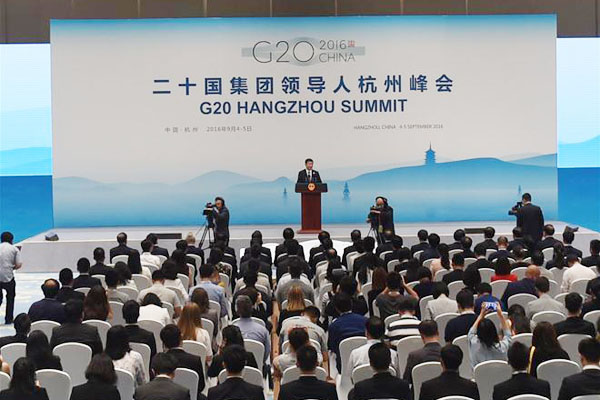
Chinese President Xi Jinping attends a press conference after the 11th summit of the Group of 20 (G20) major economies in Hangzhou, capital of east China's Zhejiang Province, Sept. 5, 2016. (Photo/Xinhua)
China, as chair of G20, made innovation a key theme for the G20 Summit, providing a new impetus to policy actions around the world to revive the global economy and achieve strong, sustainable and balanced growth. Innovation can be a powerful driver of productivity growth, the only way sustainable long-term growth can be guaranteed. And at the Hangzhou Summit, the G20 economies vowed to implement a series of ambitious structural reforms and actions to facilitate innovation, and invest in the science and technology industry, which in itself can help revive growth in many parts of the world, especially some G20 economies.
Ambitions however go much further. To foster exchange of knowledge and experience on innovation-driven growth, the G20 economies endorsed the creation of the G20 Community of Practice within the Organization for Economic Cooperation and Development-World Bank Innovation Policy Platform. They also adopted the G20 2016 Innovation Action Plan that outlines guiding principles and actions, such as adoption of pro-innovation policies and measures.
A series of action plans was adopted in related areas, too, such as the digital economy and the New Industrial Revolution.
Innovation also features in the structural reform agenda to achieve strong, sustainable and balanced growth. The G20 economies have adopted the Hangzhou G20 Guiding Principles for Structural Reform that sets the priority areas for such reform.
The importance of innovation for China and other G20 economies can be best captured by the fact that China has chosen innovative development as one of the five key principles for the 13th Five-Year Plan (2016-20), which sets the target of becoming an innovative economy by 2020. Such a transformation presupposes the accumulation of sizeable stocks of various types of capital: physical, human, institutional and social.
Physical capital is the most abundant among all types of capital. While the misallocation of capital over the past decades is manifest in excess capacity in a number of manufacturing sectors, the channelling of investment toward high-tech and new industries has been apparent in recent years.
Human capital, either measured by the expected lifetime income of individuals or simple indicators such as education attainment or enrolment, has accumulated rapidly, especially in the past two or so decades. As the share of the working-age population falls, wages rise and the relative prices of capital and labor change, leading to substitution from labor to capital. According to OECD research using the MyCOS survey data of 800, 000 tertiary graduates, the skills with the most acute shortage include computer programming and soft skills. Making up for the programming skills deficit is a prerequisite of widespread development of internet-based industries and the whole "Internet Plus" initiative.
Notwithstanding rapid productivity convergence and impressive build-up of infrastructure and knowledge over the past couple of decades, it has not been until very recently that the institutional environment is targeted to better suit the transition toward an entrepreneurial and innovative economy. Benefiting from reduced barriers to set up businesses, the past year or so saw an unprecedented surge in new company registration, particularly in services.
Once a favorable environment is established for enterprise creation, it is also crucial to ensure that zombie companies do not take up resources and through efficient mechanisms exit the market. Such "creative destruction" is the driver of productivity growth by giving space to new ideas, new products and new processes.
Overseas experience shows, that most innovation is a result of collaborative efforts, which presuppose well-established networks. While in China vertical linkages with customers and suppliers are strong and contribute to innovative activities, most achievements stem from companies' own research and development, and only a few percentages from collaborative projects. In particular, inter-company collaboration, which could potentially be an important source of spillovers, is relatively low. The first national-level manufacturing innovation platform, established in June 2016 aims at exploiting potential synergies and complementarities across activities and strengthen the link between development and commercialization.
The author Margit Molnar is head of China Desk, Economics Department of OECD.


















































